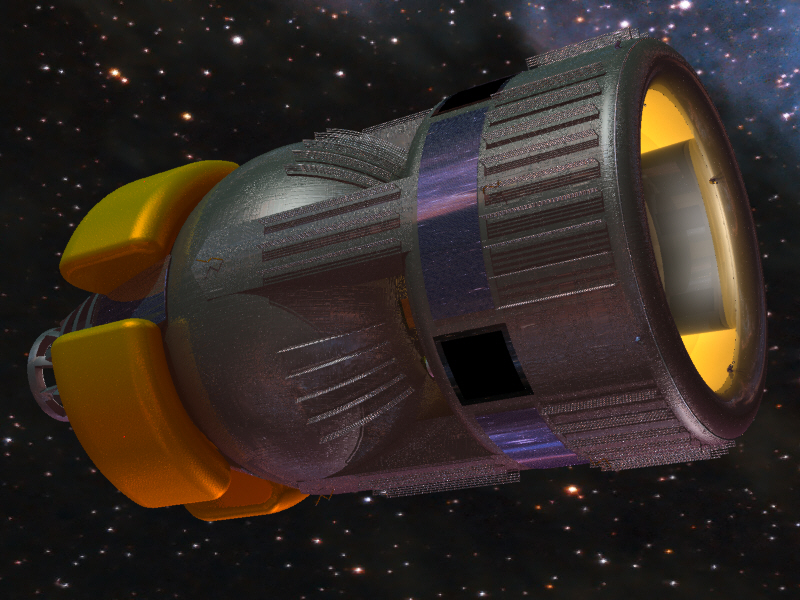Falconer's Eye System
The central star in the Falconer's Eye System is the eponymous star called the Falconer's Eye. Named for its location in an ancient Evermornan constellation known as the Falconer, the Falconer's Eye System lies roughly four light years from the Evermorn System.
Geography
The Falconer's Eye system is a relatively small star system comprised of a solitary star orbited by six major planets - of which two fall within the system's habitable band - and an asteroid belt. In order, these bodies are:
Falconer's Eye (K2-class star)
Falconer I (unnamed iron dwarf, no moons)
Ibren (terrestrial planet in close habitable zone, breathable atmosphere and carbon-based biochemistry)
Ardris (water ice moon)
Desmad (silicate moon)
Coronat (terrestrial planet in far habitable zone, chlorine atmosphere and methane/ammonia biochemistry)
Asteroid Belt
Sapfran (hydrogen-helium gas giant with silicate rings)
Sapfran I (unnamed tide-locked terrestrial ocean moon, potentially habitable)
Sapfran II (unnamed ferrous rocky moon)
Sapfran III (unnamed sulfurous rocky moon)
Falconer V (unnamed helium-methane gas giant)
Falconer V-I (unnamed volcanic moon)
Falconer V-II (unnamed ferrous moon)
Falconer V-III (unnamed ilmenite moon)
Falconer VI (unnamed nitrogen ice dwarf)
Though these are the most prominent features of the Falconer's Eye, a more distant Oort cloud and numerous other small bodies not yet fully catalogued by ESCI scientists also exist within the Falconer's Eye system. Unnamed bodies are expected to be named by the crews of the ESCI Dewhollow and ESCI Revelation as they settle the system and send spacecraft to gather resources for ongoing operations in near space.
Though these are the most prominent features of the Falconer's Eye, a more distant Oort cloud and numerous other small bodies not yet fully catalogued by ESCI scientists also exist within the Falconer's Eye system. Unnamed bodies are expected to be named by the crews of the ESCI Dewhollow and ESCI Revelation as they settle the system and send spacecraft to gather resources for ongoing operations in near space.
Ecosystem
At some point in the distant past, the Falconer's Eye system was seeded with life when asteroid mantises infested the asteroid belt and, in time, crash-landed on Ibren, Coronat, and potentially on the watery moon Sapfran I. Exposure to diverse environmental conditions on these worlds, where they weren't incompatible with life, resulted in allopatric speciation. As a result, the majority of ecosystems in the Falconer's Eye system feature extensive populations of recognizeable fungus- and lichen-like species. The arrival of humans, Lepidosians, and Feldeans - along with their closed-ecology life support systems (CELSS) aboard Protectorate-aligned colony vessels - represent new additions to the local ecosystems.
Natural Resources
The Falconer's Eye system is blessed with an abundance of life-essential elements and gasses useful for the Protectorate's preferred fusion drive and reactor technologies. Heavy metals, however, are less common there relative to the Evermorn System and, as such, must either be lofted from planetary surfaces or scrounged from the asteroid belt to support the kind of heavy on-orbit infrastructure that the Protectorate generally likes.
Tourism
The Evermorn Strategic Colony Initiative intentionally chose the Falconer's Eye System for colonization because, compared to richly-apportioned and well-traveled systems like Alpha Xymeria, Falconer's Eye is a backwater that will likely go unnoticed by potential adversaries. For this reason, aside from a minor pre-existing skyphoform presence, it is not expected that Falconer's Eye will see much in the way of tourism within the next 100 years. Communications between the colonists and the ESCI are conducted over line-of-sight methods, such as direct laser communications - and, later, the Protectorate Stellar Telegraphy Network - to reduce the potential that a hostile species will detect the burgeoning colony before there has been time for the developement of significant assets there. Further expeditions to the system may yet be undertaken to increase the colonist population in advance of exploration of Coronat and the unnamed water-rich moon of Sapfran. These planets, though marginal, may prove habitable with the proper protective equipment or after terraforming programs are initiated.
There have been reports of Aniki Labs civilian fleets forming to flee the Armoa System in search of safe harbor now that the Armoa Conflict is reaching its final chapters. Falconer's Eye is close enough to the Evermorn-Armoa Binary System that it may potentially become a destination for such an exodus, and Aniki forces are already familiar with the trajectory of the Revelation. Standing Protectorate policy is that any such unwelcome guests in the Falconer's Eye system are to be dealt with at the discretion of the colonists already in-system to best prevent the loss of life or assets therein. Armed Aniki or Cinnabar Hegemony vessels will be repelled with force, but the question of what will be done with civilian transports remains undecided due to the Cobalt Knights' obligations to preserve sentient life if possible under the Code of Evermorn. The most likely outcome of such an incursion would be the creation of a refugee flotilla at the edge of the system - perhaps in orbit over Falconer VI - until logistics allow for repatriation once the war is concluded. As many prominent members of the Revelation's crew are veterans who suffered greatly during the Armoa Conflict, including Knight-Airman Enzo Salt and Knight-Espatier Howard Mackinnon, integration of former Aniki dependents into the local population seems unlikely to be pursued with much vigor.
Primary Star
Habitability
Planetology
Type
Star System
Vehicles Present





Comments
Author's Notes
This article was submitted to Blue Fairy 47's Astralis Unofficial April Challenge:
Tagebucheintrag
| Oct 1, 2024
Look into the Stars - #Astralis